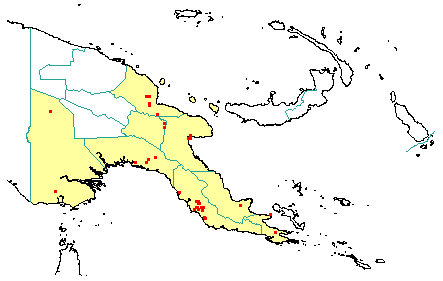
in PNGplants database
PNGTreesKey – Terminalia microcarpa Decne. |
Barry Conn (NSW) & Kipiro Damas (LAE).
Guide to trees of Papua New Guinea
Copyright held by the authors, National Herbarium of New South Wales, and Papua New Guinea National Herbarium
Nouvelles Annales du Museum d'Histoire Naturelle Vol. 3: 457 (1834)
Other Literature: M.J.E. Coode, Handbooks of the Flora of Papua New Guinea 95 (1978) Fig. 21-42.
Family: Combretaceae
Dicotyledon
Timber Group: Major exportable hardwood
Field Characters: Emergent tree (in savannah woodland) or Large canopy tree (mostly 10-30 m high); Bole cylindrical (up to c. 50 cm diam.); straight (bole 12-20 m long); buttresses buttresses present (often buttresses 0.6-1 m high); spines spines absent; aerial roots aerial roots absent; stilt roots stilt roots absent; Bark pale grey or brown, rough or smooth, scaly or flaky (flakes thick and hard) or fissured; Subrhytidome (under-bark) green or red; less than 25 mm thick, 10.0-20.0; bark blaze consisting of one layer; faintly to non-aromatic; outer blaze pale yellow, red, or brown (pale (straw-coloured), with stripes; inner blaze pale yellow, red, or brown (pale (straw-coloured), with stripes; bark exudate (sap) present, colourless, not readily flowing (spotty), colour not changing on exposure to air, not sticky; terminal buds not enclosed by leaves.
Indumentum: Complex hairs absent; stinging hairs absent; mature twig indumentum (hairs) present when young or later absent, hairs dense to sparse.
Leaves: Leaves clustered at end of branches or slightly spaced along branches, spiral (leaves occurring singly at a node and arranged spirally up the branchlet), simple (a leaf composed of a single blade); petiole present, not winged, attached to base of leaf blade, not swollen; leaves broadest above middle or sometimes broadest at or near middle, 7.0-12.0 cm, 3.5-6.0 cm; symmetric, entire, not dissected or lobed, sometimes obtuse or usually acuminate, venation pinnate, secondary veins open, prominent, intramarginal veins absent; leaves lower surface pale green, red (greenish (often), or grey (silvery), upper surface dark green, indumentum (hairs) absent when mature or present when immature, indumentum (hairs) dense to sparse; absent; domatia absent; stipules absent.
Flowers: Inflorescence axillary, flowers on an unbranched axis, cones absent; flowers unisexual and bisexual, unisexual with male and female flowers on the same plant, stalked, flowers with many planes of symmetry, 3.0 (c.) mm long, diameter small (up to10 mm diam.); perianth present, with all sepals and/or petals (hence tepals) similar, inner perianth white or pale yellow or cream-coloured; 5, some or partly joined; stamens 5, present, free of each other, free of the perianth; ovary inferior, carpels joined (when more than one), locules 1; styles solitary, 1.
Fruits: Infrutescence arranged on unbranched axis, fruit 11.0-14.0 mm long, red, not spiny, fleshy, simple, indehiscent, drupe; seeds 1, about 10 mm long, not winged, broad (as wide as long), seed 1-10 mm diam.
Distribution: Madang, Morobe, Eastern Highlands, Western, Gulf, Central, Northern & Milne Bay.
 | Botanical records in PNGplants database |
Notes: Notes Two subspecies have been proposed, namely subsp. microcarpa and subsp. incana Coode. The morphological distinction between Terminalia microcarpa subsp. incana has distinctive silvery green foliage caused by dense appressed silky hairs or grey hairs on the leaf surface. These hairs often appear slightly rusty red (at least in dry herbarium material). The mature leaves of subsp. microcarpa are sparsely hairy or glabrous (or almost so), only densely hairy when young. Therefore, the leaves are green-coloured. Although this difference is readily observable when densely hairy leaves are compared with those which are sparsely hairy or glabrous, the indumentum density varies considerably. There are no other apparent morphological differences separating these two subspecies. However, it is not known whether there are any bark features which might distinguish between these two subspecies. At this stage, it is recommended that a broad taxonomic concept be applied and so these taxa are only recognised as the single species, Terminalia microcarpa.